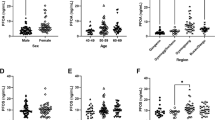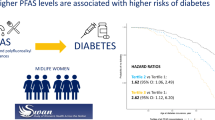Abstract
Aims/hypothesis
Several environmental contaminants, such as polychlorinated biphenyls, dioxins, bisphenol A and phthalates, have been linked to diabetes. We therefore investigated whether other kinds of contaminants, perfluoroalkyl substances (PFAS), also called perfluorinated compounds (PFCs), are also associated with diabetes.
Methods
The Prospective Investigation of the Vasculature in Uppsala Seniors (PIVUS) study investigated 1,016 men and women aged 70 years. Seven PFAS were detected in almost all participant sera by ultra-high performance liquid chromatograph/tandem mass spectrometry. Diabetes was defined as use of hypoglycaemic agents or fasting glucose >7.0 mmol/l.
Results
114 people had diabetes. In the linear analysis, no significant relationships were seen between the seven PFAS and prevalent diabetes. However, inclusion of the quadratic terms of the PFAS revealed a significant non-linear relationship between perfluorononanoic acid (PFNA) and diabetes, even after adjusting for multiple confounders (OR 1.96, 95% CI 1.19, 3.22, p = 0.008 for the linear term and OR 1.25, 95% CI 1.08, 1.44, p = 0.002 for the quadratic term). Perfluorooctanoic acid (PFOA) also showed such a relationship (p = 0.01). PFOA was related to the proinsulin/insulin ratio (a marker of insulin secretion), but none of the PFAS was related to the HOMA-IR (a marker of insulin resistance) following adjustment for multiple confounders.
Conclusions/interpretation
PFNA was related to prevalent diabetes in a non-monotonic fashion in this cross-sectional study, supporting the view that this perfluoroalkyl substance might influence glucose metabolism in humans at the level of exposure seen in the general elderly population.

Similar content being viewed by others
Abbreviations
- L-PFOS:
-
Linear isomer of perfluorooctane sulfonic acid
- PCB:
-
Polychlorinated biphenyl
- PFAS:
-
Perfluoroalkyl substances
- PFBuS:
-
Perfluorobutane sulfonic acid
- PFC:
-
Perfluorinated compound
- PFDA:
-
Perfluorodecanoic acid
- PFDS:
-
Perfluorodecane sulfonic acid
- PFDoDA:
-
Perfluorododecanoic acid
- PFHpA:
-
Perfluoroheptanoic acid
- PFHxA:
-
Perfluorohexanoic acid
- PFHxS:
-
Perfluorohexane sulfonic acid
- PFNA:
-
Perfluorononanoic acid
- PFOA:
-
Perfluorooctanoic acid
- PFOS:
-
Perfluorooctane sulfonic acid
- PFOSA:
-
Perfluorooctane sulfonamide
- PFPeA:
-
Perfluoropentanoic acid
- PFTrDA:
-
Perfluorotridecanoic acid
- PFUnDA:
-
Perfluoroundecanoic acid
- PIVUS:
-
Prospective Investigation of the Vasculature in Uppsala Seniors
- PPAR:
-
Peroxisome proliferator-activated receptor
References
Paul AG, Jones KC, Sweetman AJ (2009) A first global production, emission, and environmental inventory for perfluorooctane sulfonate. Environ Sci Technol 43:386–392
Kennedy GL Jr, Butenhoff JL, Olsen GW et al (2004) The toxicology of perfluorooctanoate. Crit Rev Toxicol 34:351–384
Conder JM, Hoke RA, de Wolf W, Russell MH, Buck RC (2008) Are PFCAs bioaccumulative? A critical review and comparison with regulatory criteria and persistent lipophilic compounds. Environ Sci Technol 42:995–1003
Lau C, Anitole K, Hodes C, Lai D, Pfahles-Hutchens A, Seed J (2007) Perfluoroalkyl acids: a review of monitoring and toxicological findings. Toxicol Sci 99:366–394
Svensson K, Hernandez-Ramirez RU, Burguete-Garcia A et al (2011) Phthalate exposure associated with self-reported diabetes among Mexican women. Environ Res 111:792–796
Lind PM, Zethelius B, Lind L (2012) Circulating levels of phthalate metabolites are associated with prevalent diabetes in the elderly. Diabetes Care 35:1519–1524
James-Todd T, Stahlhut R, Meeker JD et al (2012) Urinary phthalate metabolite concentrations and diabetes among women in the National Health and Nutrition Examination Survey (NHANES) 2001–2008. Environ Health Perspect 120:1307–1313
Nelson JW, Hatch EE, Webster TF (2010) Exposure to polyfluoroalkyl chemicals and cholesterol, body weight, and insulin resistance in the general U.S. population. Environ Health Perspect 118:197–202
Lv Z, Li G, Li Y et al (2013) Glucose and lipid homeostasis in adult rat is impaired by early-life exposure to perfluorooctane sulfonate. Environmental toxicology 28:532–542
Leonard RC, Kreckmann KH, Sakr CJ, Symons JM (2008) Retrospective cohort mortality study of workers in a polymer production plant including a reference population of regional workers. Ann Epidemiol 18:15–22
MacNeil J, Steenland NK, Shankar A, Ducatman A (2009) A cross-sectional analysis of type II diabetes in a community with exposure to perfluorooctanoic acid (PFOA). Environ Res 109:997–1003
Lin CY, Chen PC, Lin YC, Lin LY (2009) Association among serum perfluoroalkyl chemicals, glucose homeostasis, and metabolic syndrome in adolescents and adults. Diabetes care 32:702–707
Vasiliu O, Cameron L, Gardiner J, Deguire P, Karmaus W (2006) Polybrominated biphenyls, polychlorinated biphenyls, body weight, and incidence of adult-onset diabetes mellitus. Epidemiology 17:352–359
Turyk M, Anderson H, Knobeloch L, Imm P, Persky V (2009) Organochlorine exposure and incidence of diabetes in a cohort of Great Lakes sport fish consumers. Environ Health Perspect 2117:1076–1082
Lee DH, Steffes MW, Sjödin A, Jones RS, Needham LL, Jacobs DR Jr (2010) Low dose of some persistent organic pollutants predicts type 2 diabetes: a nested case–control study. Environ Health Perspect 118:1235–1242
Rignell-Hydbom A, Lidfeldt J, Kiviranta H et al (2009) Exposure to p,p′-DDE: a risk factor for type 2 diabetes. PloS one 4:e7503
Lee DH, Lind PM, Jacobs DR Jr, Salihovic S, van Bavel B, Lind L (2011) Polychlorinated biphenyls and organochlorine pesticides in plasma predict development of type 2 diabetes in the elderly: the Prospective Investigation of the Vasculature in Uppsala Seniors (PIVUS) study. Diabetes Care 34:1778–1784
Lang IA, Galloway TS, Scarlett A et al (2008) Association of urinary bisphenol A concentration with medical disorders and laboratory abnormalities in adults. JAMA 300:1303–1310
Lind L, Fors N, Hall J, Marttala K, Stenborg A (2005) A comparison of three different methods to evaluate endothelium-dependent vasodilation in the elderly: the Prospective Investigation of the Vasculature in Uppsala Seniors (PIVUS) study. Arterioscler, Thromb, Vasc Biol 25:2368–2375
Carlsson L, Lind L, Larsson A (2010) Reference values for 27 clinical chemistry tests in 70-year-old males and females. Gerontology 56:259–265
Davies MJ, Rayman G, Gray IP, Day JL, Hales CN (1993) Insulin deficiency and increased plasma concentration of intact and 32/33 split proinsulin in subjects with impaired glucose tolerance. Diabet Med 10:313–320
Kahn SE, Halban PA (1997) Release of incompletely processed proinsulin is the cause of the disproportionate proinsulinemia of NIDDM. Diabetes 46:1725–1732
Matthews DR, Hosker JP, Rudenski AS, Naylor BA, Treacher DF, Turner RC (1985) Homeostasis model assessment: insulin resistance and beta-cell function from fasting plasma glucose and insulin concentrations in man. Diabetologia 28:412–419
Salihovic S, Karrman A, Lindstrom G, Lind PM, Lind L, van Bavel B (2013) A rapid method for the determination of perfluoroalkyl substances including structural isomers of perfluorooctane sulfonic acid in human serum using 96-well plates and column-switching ultra-high performance liquid chromatography tandem mass spectrometry. J Chromatogr, A 1305:164–170
Lebovitz HE, Banerji MA (2001) Insulin resistance and its treatment by thiazolidinediones. Recent Prog Horm Res 56:265–294
Lupi R, Del Guerra S, Marselli L et al (2004) Rosiglitazone prevents the impairment of human islet function induced by fatty acids: evidence for a role of PPARγ2 in the modulation of insulin secretion. Am J Physiol Endocrinol Metab 286:E560–E567
Thomas EL, Potter E, Tosi I et al (2007) Pioglitazone added to conventional lipid-lowering treatment in familial combined hyperlipidaemia improves parameters of metabolic control: relation to liver, muscle and regional body fat content. Atherosclerosis 195:e181–e190
Moon JH, Kim HJ, Kim SK et al (2011) Fat redistribution preferentially reflects the anti-inflammatory benefits of pioglitazone treatment. Metabolism 60:165–172
Vongphachan V, Cassone CG, Wu D, Chiu S, Crump D, Kennedy SW (2011) Effects of perfluoroalkyl compounds on mRNA expression levels of thyroid hormone-responsive genes in primary cultures of avian neuronal cells. Toxicol Sci 120:392–402
Dallaire R, Dewailly E, Pereg D, Dery S, Ayotte P (2009) Thyroid function and plasma concentrations of polyhalogenated compounds in Inuit adults. Environ Health Perspect 117:1380–1386
Power MC, Webster TF, Baccarelli AA, Weisskopf MG (2013) Cross-sectional association between polyfluoroalkyl chemicals and cognitive limitation in the National Health and Nutrition Examination Survey. Neuroepidemiology 40:125–132
Funding
This study was supported by the Swedish Research Council (VR) and the Swedish Research Council for Environment, Agricultural Sciences and Spatial Planning (FORMAS).
Duality of interest
The authors declare that there is no duality of interest associated with this manuscript. No potential conflicts of interest relevant to this article were reported. BZ is employed by the Medical Products Agency (MPA), Uppsala, Sweden, and the views of the present study are not necessarily official views of the MPA.
Contribution statement
PML conceived the project and contributed to critical revision of the manuscript for important intellectual content. BZ was responsible for laboratory analyses of insulin and proinsulin measurements. LL performed data analysis. Also, LL is principal investigator of PIVUS and had full access to all the data in the study and takes responsibility for the integrity of the data and the accuracy of the data analysis. SS and BvB performed the analysis of the PFAS. LL wrote the first draft of the manuscript. All authors contributed to critical revision of the manuscript and approved the final version of the manuscript.
Author information
Authors and Affiliations
Corresponding author
Rights and permissions
About this article
Cite this article
Lind, L., Zethelius, B., Salihovic, S. et al. Circulating levels of perfluoroalkyl substances and prevalent diabetes in the elderly. Diabetologia 57, 473–479 (2014). https://doi.org/10.1007/s00125-013-3126-3
Received:
Accepted:
Published:
Issue Date:
DOI: https://doi.org/10.1007/s00125-013-3126-3




